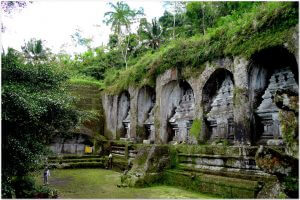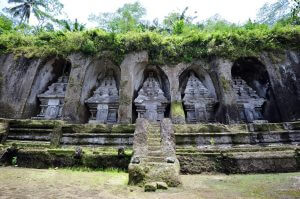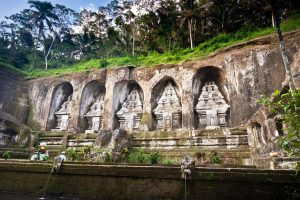
Bali: Gunung Kawi Temple Complex
 1
1
 07. 07. 2018
07. 07. 2018

Gunung Kawi is ancient Hindu cave temple, located on the island of Bali in Indonesia. In the Pakrisan valley, near the village of Tampaksiring and about 25 kilometers north of Ubud. It is a set of caves and shrines carved into the rock.
The way to Gunung Kawi
To visit the temple in the river valley, you have to descend after 371 stairs. Along the stairs are terraced rice fields, and the quiet sound of water from the irrigation channels and the river predominates.
When you find yourself in the complex, you can admire the cut bas-reliefs, seven meters high, which they call chandis. Four of them are on the west bank and another five on the east bank of the river. These are tombstones with inscriptions on which of the royal family they are dedicated to. The word chandi refers to the abode of the goddess of death and the wife Shiva Kali. Similar buildings testify to the strong influence of Indian architecture, and in India itself we can find such complexes in many places.
The origin of Gunung Kawi
Gunung Kawi was probably created by King Anak Wungsu in 1080 AD in honor of his father, King Udayana - the great ruler. No human remains or ashes were found in the chandi. It is therefore hypothesized that these are not tombstones, but symbolic monuments to members of the royal family.
On the eastern side of the river there is a water drain under the chasm - the water flows through the tombs already 1000 years and is considered to be healing. Somewhat above, above Gunung Kawi, is the sacred spring and temple of Tirta Empul. All the sacred water in Bali springs from the alpine lakes.
To the right of the chin, on the east side, is the central courtyard, around which there are niches, where pilgrims who had to be confined before entering were laid to sleep.
If we follow the east bank along the river, we will find several more niches in the rock, they are 8 meters long, 2-3 in width and 2,5 in height. Even further south are about 30 small rooms, which are created from caves by cutting. Many of them have extraordinary acoustics, ideal for meditation and for setting certain energy vibrations. The ancient caves served as spaces for meditation.
Gunung Kawi and spiritual development
The specific purpose of all buildings in this temple complex remains a mystery to this day. But experts believe that Gunung Kawi was built due to spiritual development - unlike traditional Hindu temples, which were mainly places for rituals.








